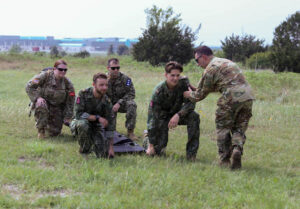
Story by Capt. Luis Alani
222nd Broadcast Operations Detachment
FORT CAVAZOS, Texas — The countdown has begun for the 2024 Joint Emergency Medicine Exercise JEMX, taking place June 2nd through 7th at Fort Cavazos, Texas. This annual training event, unlike any other military exercise, will bring together over 100 medical personnel from the U.S. Army, Navy, and Air Force, as well as several NATO partners, to engage in realistic combat casualty care training.
The purpose of JEMX is to increase unit and individual combat readiness and joint interoperability between medical staff from multiple military branches. Throughout the week-long exercise, trainees will receive didactic instruction on the latest advancements in Tactical Combat Casualty Care TCCC, as well as care of military working dogs, medical planning, and autologous fresh whole blood transfusions.
But the real action will take place during the tactical medical care scenarios, or “lanes,” where trainees will put their skills to the test by responding to simulated combat situations. These scenarios will challenge trainees to employ TCCC in evacuating and transferring casualties through role 1, 2, and 3 medical facilities. Additionally, other scenarios will test trainees’ abilities to operate in prolonged field care in resource-limited settings, similar to what they may encounter in near-peer conflicts.
JEMX is a one-of-a-kind training event that provides a unique opportunity for medical personnel to work together in a joint environment, enhancing their individual and collective skills in combat casualty care. This exercise will also promote collaboration and cooperation between different military branches and NATO partners, ultimately improving the overall effectiveness of medical response during combat missions.